11 May: Easter Island
We arrived in Mateveri airport at 9:25 after a very short
night: we
had about
4 hours
sleep. We
were
welcomed
at the
airport
by
our
hosts
Antoine
and Lolita
with a
necklace
made of
flowers
and leaves
and driven
with three
other
guests
(Pierre-Paul,
Robert and
Geneviève)
to the
B&B.
After an introductory talk about the island from our hosts, we
rented a
small jeep
for the
rest of
the day to
start
exploring
the
west
coast
of
the
island.
We
ate
lunch
in
Hanga
Roa the
island's unique village
and bought
a map to
start our
explorations.
Our first
stop was
at Ahu
Tahai and
Ahu Va
Huri where
we
saw the
only fully
restored
moai with
a red head
piece
(pukao)
and
eyes
made
from white
coral and
black
volcanic
glass. The
moai
statues,
representing
important
deceased
ancestors, vary
in
size
from
a few
metres to
10 metres,
weighing
from 5-10
tonnes to
82
tonnes. They
all stand
majestically
on
platforms,
guarding
the former
villages
and their
residents
from bad
spirits. We
then saw
another
moai
platform,
Ahu
Kote
Riku
and
continued
our drive
on the 4WD
track to a
couple
of
caves.
The
caves
are
in
fact
lava
tubes
and
where
used as
shelters
and even
dwellings
for the
island's
inhabitants.
Unfortunately
we hadn't
brought a
lamp, but
François
and Gaelle
managed to
find their
way
through
the pitch
black tunnel
in Ana
Kakenga
to
the two
windows in
the cliffs
on the
shore.
We also saw Ahu Te Peu, a platform in ruins with fallen and
decapitated moais.
The most
impressive
site of
the day
was
the
restored
seven
moais, Ahu
Akivi.
These are
the
only moais to face
the sea
and legend
has it
that the
statues
represent
the seven
warriors
send by
Hotu
Matu'a to
take
possession
of the
island.
Our final stop was the Pukaos Quarry where the head pieces are
carved out
of the red
volcanic
rock. Many
pukao have
been left
unfinished
and
abandoned
at the
site and
never
found
their way
to
decorate
a
moai on
a
platform...
In the evening we ate dinner in a modest local restaurant in the
village.
The girls
made a
fuss to
eat their
meal and
we
promised
ourselves
to feed
them prior
to going
to a
restaurant
the next
day...
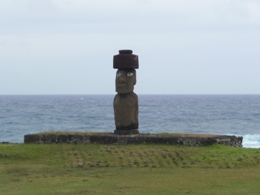 |
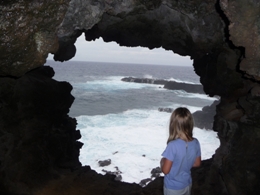 |
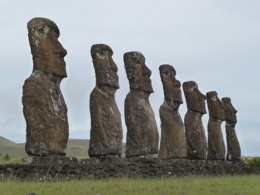 |
| Ahu Tahai,
with
retored
eyes |
One of the
lava
tube
windows
looking
out
to
sea |
The seven
moais,
Ahu
Te
Peu |
12 May: Guided tour of Easter Island
We over slept this morning and had 15 minutes to get up, washed,
dressed
and eat
breakfast
before our
tour! A
bit of a
rush, but
we
managed!
Pierre-Paul,
Robert and
Geneviève
joined us
on the
tour of
the east
coast of
the
island.
Richard
our French
guide
drove us
in a small
mini bus
around the
major
sites,
giving us
very
interesting
commentaries
along the
way. It
was also
our chance
to ask
lots of
questions
about the
culture
and the
sites that
we had
accumulated
from the
previous
day. We
first
visited a
couple of
ahu
(platforms)
in ruins
with fallen moai
and then
went to
the
Rano
Raraku crater.
This is
probably
the most
stunning
site on
the
island. It
was the
crater
from which
all the
moai
statues
were
carved. Once
carved the
moai were
brought
down the
slopes
of
the
volcanic
crater and
transported
all over
the island
to
the dedicated
platforms.
The quarry
was
abandoned
sometime
in
the
15th
or
16th
century
and
hundreds
of statues
remain
half
carved
in
the
volcanic
rock or
abandoned
during
transportation
on the
slopes
of
the
crater.
It's
amazing to
see a
snapshot
of the
fabrication
of these
mythical
statues.
How they
managed to
transport
these
statues
over tens
of
kilometres
remains a
mystery...
Next we saw the royal site, Ahu Tongariki where 15 moai stand
majestically
on a vast
platform
before
heading to
the beach
at
Anakena. The
moais at
Ahu Nau
Nau,
surrounded
by a
coconut
grove
and
the
beach,
still
have
carvings
on the
backs, but
the
meanings
of these
engravings
are not
known.
Gaelle and
Sophie
went
for a
swim
in
the
waves
accompanied
by Pierre-Paul
and
Geneviève.
The water
was much
colder
than that
in French
Polynesia
so
Jenny
and
François
abstained!
In the evening we rented another 4WD and returned to the village
with
Pierre-Paul.
We sent a
few
e-mails to
try and
book a
room in
Lima,
our
next
stop,
fed
the
girls
and
then
went
to
eat in
a
nice
cafe,
Ra'a.
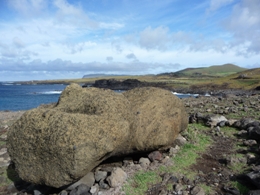 |
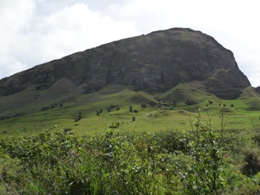 |
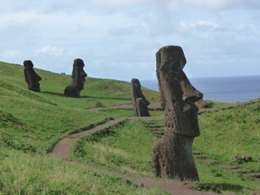 |
| A fallen
moai... |
The maoi
quarry
at
Rano
Raraku |
The abandoned
moais
at
Rano
Raraku |
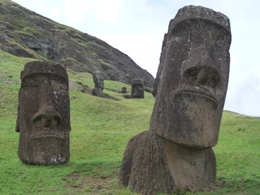 |
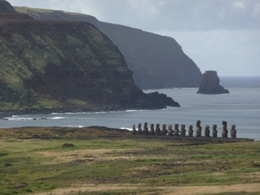 |
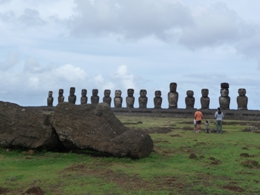 |
| Some of the
300
odd
abandoned
moais
at
the
quary |
Ahu
Tongariki |
Ahu Tongariki
with
an
abandoned
moai
in
the
foreground
(broken
during
transport) |
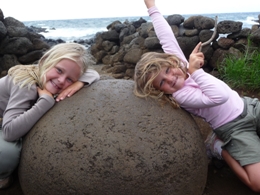 |
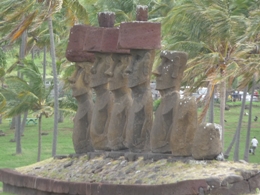 |
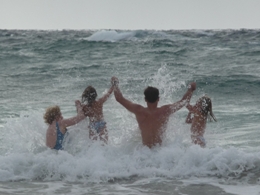 |
| The learning
stone,
a
volcanic
stone
in
an
old
village |
Ahu Nau Nau at
Anakena
beach |
The
girls
playing
in
the
waves
with
Pierre-Paul
and
Geneviève |
13 May: Orongo and Poike
We started the day at Ana Kai Tangata where there's a cave with
birdlike
(Manutara
rock
paintings)
and a lava
tube. Next
stop was
the
birdman
ceremonial
village of
Orongo.
The
village
was
built following
the
introduction
of of the
Make-Make
god cult,
after the
decline of
the
ancestor
worship
(moai
cult)
in
the
16th
century.
The
village
consists
of 54
stone
houses
which
were
inhabited
for only a
few weeks
per year
at the
time of
the
Tangata-Manu
(birdman)
competition.
There are
also many
petroglyphs
of the
birdman
and the
Make-Make
god. The
crater of
the
Rano
Kau
volcano
next to
the
village is
spectacular: a
circular
crater
measuring
1.6kms
across
filled by
a lake.
Our next stop was at Ahu Vinapu, to see the moai platform in
ruins. The
platform
here was
built with
huge
carved
rocks,
perfectly
joined
leading
certain
archeologists
to draw a
parallel
with Inca
constructions
and hence
raising
the theory
that the
island's
inhabitants
were of
Inca
origin.
After a picnic lunch we headed to the far eastern point of the
island,
the Poike
peninsula.
We set off
for a 2.5
hour walk
around
the
volcano
and
surrounding
three
hills,
called
Maunga
(breasts).
On
the
largest
hill
there's a
2 metre
high
carved
face with
an open
mouth,
in
which
rain
water
collects. We
tried to
spot the
headless
moai in a
cave on
the hill
without
success,
so
climbed
up to
the
summit
of
the
volcano,
from where
we had a
lovely
view of
the
island
and
of the
nearby
moai
quarry,
Rano
Raraku. On
the
way down
the slopes
of the
volcano we
saw a
solitary
standing
moai,
the
island's
smallest
moai,
measuring
about 1m.
We
continued
our
drive
around
the
island
and
stopped
off at
Papa Vaka
to see
some
petroglyphs
(a large
canoe,
fish
hooks,
turtles, a
shark and
tuna).
In the evening we returned to the village with Pierre-Paul,
dropping
off our
rental
car. We
managed to
confirm a
room for
the
first
two
nights
in
Peru,
before
dining in
a nice
cafe-bar.
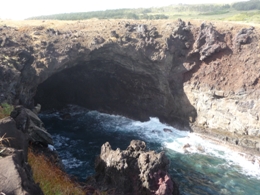 |
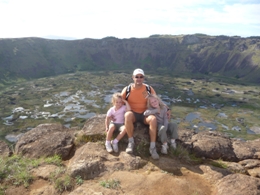 |
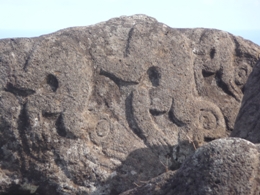 |
| The lava tube
next
to
Ana
Kai
Tangata |
The Rano Kau
crater
|
Birdman
petroglyphs
at
Orongo |
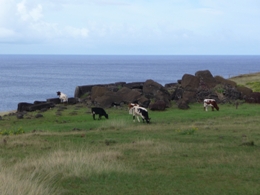 |
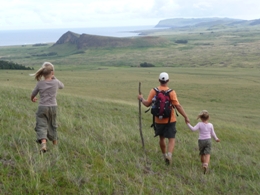 |
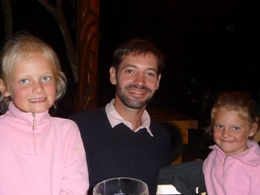 |
| An ahu in
ruins
at
Ahu
Vinapu,
with
grazing cows |
Walking down
the
volcano
with
Rano
Kau
in the background |
Pierre-Paul
and
the
girls |
14 May: Flight to Peru
We spent all day in planes flying to Lima via Santiago du Chili.
We arrived
at
midnight tired out...

BACK
| 
